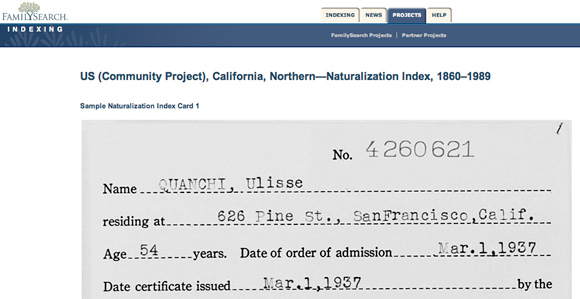FamilySearch Launches New Indexing Initiative as 1940 Census Effort Winds Up
Contributed By By Heather Whittle Wrigley, Church News and Events

The immigration and naturalization indexing project, which is now available through FamilySearch indexing, includes records of immigrants through all major U.S. ports from the 1800s to the 1950s.
Article Highlights
- FamilySearch recently launched a new genealogy initiative, the U.S. Immigration and Naturalization Community Project.
- The new initiative is an opportunity to make more searchable family history records available and to extend the information available surrounding the 1940 U.S. Census indexing project, which is nearing completion this month.
- FamilySearch representatives are seeking additional volunteers to help index and arbitrate the new records, which in total will far outnumber the 1940 Census’s 132 million records.
Related Links
- Visit the main page of FamilySearch’s new Immigration and Naturalization project to learn more.
- View a story about the launch of the 1940 U.S. Census indexing project.
- Follow the progress of the 1940 U.S. Census Indexing project online.
- Read about a FamilySearch Indexing app that helps individuals to contribute to family history one record at a time.
As the 1940 U.S. Census Community Project nears completion this month, FamilySearch is providing enthusiastic indexers and arbitrators the opportunity to seamlessly transition into the next big genealogy initiative—the U.S. Immigration and Naturalization Community Project, which includes records of those who passed through all major U.S. ports from the 1800s to the 1950s.
“The U.S. Immigration and Naturalization Project will help document the lives of immigrant ancestors who came to live in the United States,” said Michael Judson, the indexing workforce development manager for FamilySearch. “This is an opportunity for volunteers to provide even more searchable records, especially for family historians who are looking for information that will link their ancestors to their native lands.”
The new project contains a substantially larger number of records than the 1940 U.S. Census does, so FamilySearch representatives expect it will take more time and additional volunteers.
Launched on April 2, the 1940 U.S. Census Community Project, comprising 132 million records, will be completed nearly two months ahead of schedule, thanks to unprecedented efforts by indexers and arbitrators around the world.
Before the 1940 U.S. Census project was launched, the most records indexed and arbitrated in one day in the history of FamilySearch topped out at 3 million. Enthusiasm for the 1940 U.S. Census drove that number to a new all-time record of just under 4.9 million on April 30.
In one day alone, however, on July 1–2, 46,000 volunteers performed 10 million indexing tasks, more than twice as many as on any other day in the history of indexing.
“The completion of such a huge project in such a short period is a remarkable achievement,” said Jim Ericson, a product marketing manager from FamilySearch. He further pointed out that about 20 percent of those who participated were not members of the LDS Church. “Many of our volunteers are genealogical society leaders and members,” he said.
The U.S. Immigration and Naturalization Community Project, like the census project, draws on a collaborative community of commercial partners, genealogical societies, archivists, and others with an interest in making genealogical records searchable online.
A few collections of records are already available for indexing at indexing.FamilySearch.org, under “Current Projects,” including a collection of passenger lists from New Orleans, Louisiana, USA, dating from 1820 to 1945. Another section of the community project—a card index to naturalization records from Northern California—is also available under the list of current projects.
Most of the record sets in the immigration and naturalization project involve passenger lists and naturalization records. All collections available as part of the new “Community Project” are designated by the prefix “US (Community Project).”
Katie Gale of the FamilySearch indexing workforce development team emphasized that tracking an individual’s records from their country of immigration to their country of origin is one of the most difficult tasks in family history work.
“These immigration and naturalization records will open doors to generations of family members left behind when our ancestors departed their native lands,” she said.
For more information about the U.S. Immigration and Naturalization Community Project and to learn how to get involved, visit the project website.
